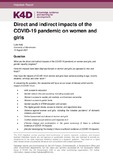Direct and Indirect Impacts of the COVID-19 Pandemic on Women and Girls
Abstract
This rapid literature review finds that women have been disproportionately affected by Covid-19 in several ways. As the Covid-19 pandemic began, it was widely predicted that women would face worse outcomes than men in many spheres. This was based on evidence of pre-existing inequalities (e.g. the high share of women in informal work) and evidence from earlier disease outbreaks such as Ebola. Evidence from the past year and a half supports the idea that women have been disproportionately affected by Covid-19 in many of the issues investigated for this report. A wide-ranging World Bank review of evidence from April 2020 to April 2021 states that “women often appear to have lost out more than men economically and socially” (Nieves et al., 2021, p. 4). It was not possible to find evidence on the effect of Covid-19 on women’s role in the green economy and the effects of climate change (beyond calls for inclusive green growth), or on gender stereotyping in the media (although there is a small amount of literature on perceptions of women leaders during the pandemic). In all cases, the effect of Covid-19 and measures to suppress it have directly or indirectly continued or worsened pre-existing inequalities. In some instances, Covid-19 has created distinct difficulties for women (e.g. lockdowns and increased domestic violence). This report has found no evidence of Covid-19 improving the position of women in the areas of interest surveyed, beyond possible benefits from working from home for some women in high-income countries; and some suggestions that female leadership during the pandemic may lead to better perceptions of women (Piazza & Diaz, 2020). Studies also point to the intersection of gender with other factors, such as caste and ethnicity, leading to worse outcomes (Chen et al., 2021; Kabeer et al., 2021). In many cases, migrant women and women with disabilities are at an increased disadvantage. The report focuses on evidence from low- and middle-income countries (LMICs) and G7 members. It is not comprehensive but surveys the available evidence focusing on global, regional or synthesis evidence to provide a more representative coverage. It, therefore, does not cover every context or provide any country case studies and overlooks variations in some countries in favour of broader trends.
Citation
Kelly, L. (2021). Direct and indirect impacts of the COVID-19 pandemic on women and girls. K4D Helpdesk Report. Institute of Development Studies, DOI: 10.19088/K4D.2021.141DOI
10.19088/K4D.2021.141Is part of series
K4D Helpdesk Report;1038Rights holder
© Crown copyright 2021Sponsor
FCDO (Foreign, Commonwealth and Development Office)Collections
- K4D COVID-19 Resources [213]

